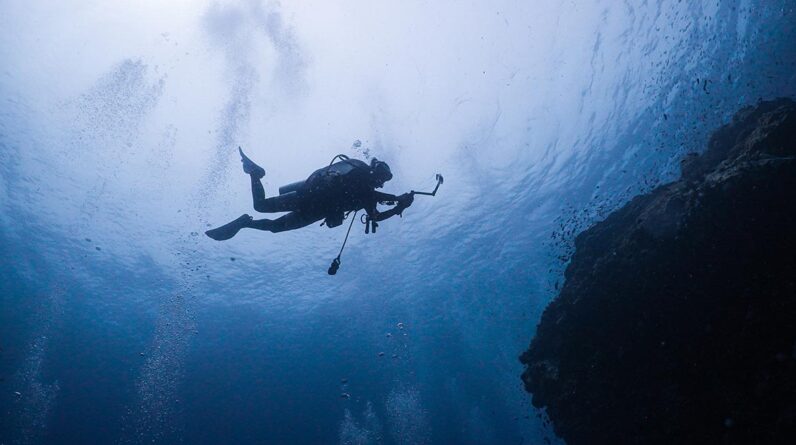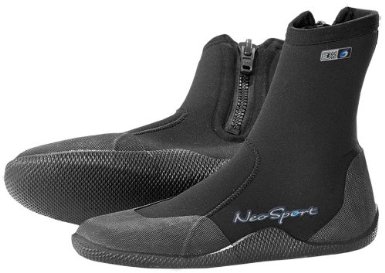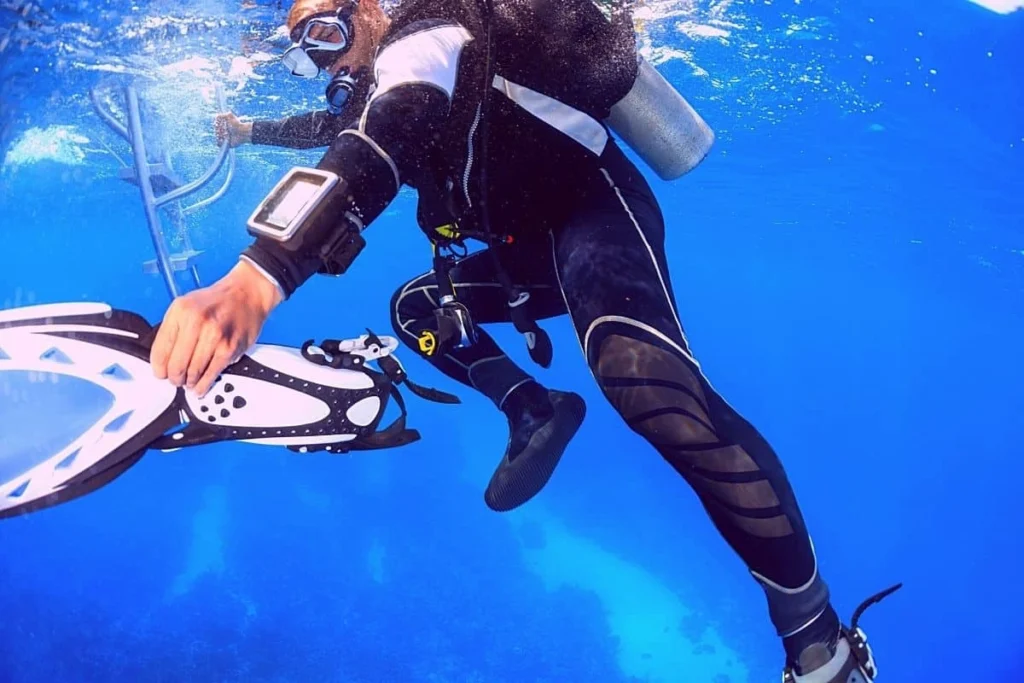
Are you passionate about scuba diving and want to ensure that your gear stays in top-notch condition? Look no further! In this comprehensive guide, we will walk you through the essential steps of caring for your scuba diving wetsuit boots. From cleaning and drying techniques to proper storage methods, we’ve got you covered. By following these simple yet effective tips, you’ll be able to extend the lifespan of your boots and continue diving with confidence. So, let’s dive straight into the world of wetsuit boot care!

This image is property of www.scuba-diving-smiles.com.
Cleaning Your Scuba Diving Wetsuit Boots
Removing Sand and Debris
When it comes to cleaning your scuba diving wetsuit boots, the first step is to remove any sand and debris. Before leaving the beach or dive site, take a moment to shake out your boots to get rid of any loose sand or small pebbles. This will prevent these abrasive particles from causing damage to the neoprene material of your boots.
Rinsing with Fresh Water
After removing the initial sand and debris, it’s important to thoroughly rinse your wetsuit boots with fresh water. This will remove any remaining saltwater, chlorine, or dirt that may have accumulated during your dive. Use a hose or faucet with a gentle stream of water to rinse the boots inside and out. Pay special attention to the crevices and seams to ensure all the contaminants are washed away.
Using Mild Soap for Stubborn Dirt
If your scuba diving wetsuit boots have stubborn dirt or stains that won’t come off with just water, you can use a mild soap specifically designed for neoprene products. Avoid using any harsh or abrasive chemicals, as they can degrade the neoprene material and reduce the lifespan of your boots. Gently scrub the affected areas with a soft cloth or sponge using the mild soap solution. Rinse thoroughly with fresh water afterward to remove any soap residue.
Avoiding Harsh Chemicals
While it may be tempting to use strong detergents or bleach to get your wetsuit boots squeaky clean, it’s best to avoid these harsh chemicals. They can damage the neoprene material and cause it to become brittle or crack over time. Stick to mild soaps or specialized neoprene cleaners to ensure the longevity of your boots. It’s also important to avoid using fabric softeners, as they can leave a residue that hinders the boots’ ability to retain warmth.
Drying Your Scuba Diving Wetsuit Boots
Hang Drying
After cleaning your scuba diving wetsuit boots, it’s crucial to properly dry them to prevent the growth of mold and mildew. The most effective method is to hang dry them in a well-ventilated area. Find a sturdy hanger or line to hang your boots upside down, allowing any excess water to drip out. Make sure the boots are not touching the ground or any other surfaces that may introduce dirt or debris.
Avoid Direct Sunlight
While sunlight can help expedite the drying process, it’s important to avoid exposing your wetsuit boots to direct sunlight for extended periods. The UV rays can degrade the neoprene material and cause it to lose flexibility and strength. If possible, choose a shaded area for drying your boots or cover them with a towel to protect them from direct sunlight.
Using a Wetsuit Hanger
Investing in a wetsuit hanger can greatly aid in the drying process. These hangers are designed specifically for wetsuits and boots, with wide shoulders to prevent stretching and clips to hang your boots securely. By using a hanger, you ensure that your boots maintain their shape while drying and allow for proper airflow, speeding up the drying time.
Ensuring Proper Ventilation
Proper ventilation is crucial when drying your scuba diving wetsuit boots. Choose a well-ventilated area with good airflow to prevent moisture from being trapped in the boots. Avoid drying them in a closed or humid environment, as this can lead to the growth of mold and mildew. If necessary, you can use a fan or dehumidifier to enhance air circulation and speed up the drying process.
Preventing Mold and Mildew
Inspection After Each Dive
To prevent the growth of mold and mildew, it’s important to inspect your scuba diving wetsuit boots after each dive. Look for any signs of dampness or moisture, as this can indicate that the boots were not properly dried. If you notice any wet spots, make sure to thoroughly dry them before storing to prevent the growth of mold and mildew.
Thorough Drying
As mentioned earlier, thorough drying is crucial to prevent mold and mildew. Even a small amount of moisture left in the boots can provide a breeding ground for these unwanted invaders. After rinsing and cleaning your boots, ensure they are completely dry before storing them. Use a towel to pat them dry or let them air dry in a well-ventilated area. Pay extra attention to the soles and seams, as these areas often take longer to dry.
Applying a Neoprene Conditioner
To further protect your scuba diving wetsuit boots from mold and mildew, consider applying a neoprene conditioner after cleaning and drying them. Neoprene conditioners help rejuvenate the material, keeping it supple and resistant to mold growth. Follow the manufacturer’s instructions for the correct application method and frequency. Remember to avoid applying the conditioner to the boots’ soles, as it may compromise their grip on slippery surfaces.
Proper Storage
Proper storage is key to preventing mold and mildew from developing on your scuba diving wetsuit boots. Before storing, ensure that your boots are completely dry. Store them in a cool, dry place away from direct sunlight or excessive heat. Avoid folding or creasing the boots, as this can damage the neoprene material. If possible, use a wetsuit hanger or a mesh bag to hang or store your boots, allowing for adequate air circulation and reducing the risk of mold growth.
Repairing Small Tears and Punctures
Gather Necessary Materials
Over time, your scuba diving wetsuit boots may develop small tears or punctures. To repair these damages, gather the necessary materials. You will need neoprene adhesive, a patch of neoprene or a repair kit specifically designed for wetsuits. These materials are readily available at dive shops or online.
Cleaning the Affected Area
Before applying the neoprene adhesive, clean the affected area of your scuba diving wetsuit boots. Remove any dirt or debris surrounding the tear or puncture. Gently wipe the area with a soft cloth or sponge dipped in fresh water to ensure it is clean and ready for repair.
Applying Neoprene Adhesive
Once the area is clean, apply the neoprene adhesive according to the manufacturer’s instructions. Use a small brush or spatula to spread a thin and even layer of adhesive over the tear or puncture. Allow the adhesive to dry for the recommended amount of time. Be patient during this process, as it is important to ensure a strong and lasting bond.
Allowing Sufficient Drying Time
After applying the neoprene adhesive, allow your scuba diving wetsuit boots to dry for the recommended time. This will ensure that the repair is fully set and bonded. Avoid rushing the drying process, as premature use may cause the repair to fail. Once you are confident that the repair is dry and secure, you can resume using your boots with peace of mind.

This image is property of proadventureguide.com.
Avoiding Excessive Wear and Tear
Choosing the Right Size
To avoid excessive wear and tear on your scuba diving wetsuit boots, it’s crucial to choose the right size. Ill-fitting boots can lead to discomfort, blisters, and increased friction on the material. Take accurate measurements of your feet and refer to the manufacturer’s size chart to find the perfect fit. Remember that a slightly snug fit is preferable to ensure optimal performance without compromising comfort.
Putting on and Taking off Properly
Improperly putting on or taking off your scuba diving wetsuit boots can cause unnecessary stress on the material and seams. To avoid this, use your fingers to gently guide your foot into the boot. Avoid using excessive force or pulling on the material, as this can stretch or damage it over time. When removing the boots, take your time and carefully slide them off, avoiding any unnecessary tugging or twisting.
Avoiding Walking on Hard Surfaces
Scuba diving wetsuit boots are designed for water activities and typically have soft and flexible soles. Walking on hard surfaces such as concrete or rocky terrain can cause excessive wear and tear on the boots. Whenever possible, avoid walking on these types of surfaces while wearing your boots. Instead, use booties or water shoes with thicker soles for land-based activities.
Keeping Fingernails Trimmed
Long or sharp fingernails can accidentally puncture or tear your scuba diving wetsuit boots while putting them on or taking them off. To prevent this, keep your fingernails trimmed and smooth. Regularly inspect your nails for any rough edges or snags that could potentially damage the boots. By maintaining well-groomed nails, you reduce the risk of accidental tears or punctures.
Dealing with Saltwater and Chlorine Exposure
Rinsing Boots after Saltwater Exposure
Saltwater can be corrosive to the neoprene material of your scuba diving wetsuit boots if not properly rinsed off. After saltwater exposure, thoroughly rinse your boots with fresh water. Pay extra attention to the seams, as salt crystals can accumulate and cause premature wear. Rinse until all traces of salt are removed, ensuring the longevity of your boots.
Soaking in Fresh Water with Mild Soap
If your scuba diving wetsuit boots have been exposed to chlorine, it’s important to take extra steps to remove any residue. After rinsing with fresh water, soak your boots in a bucket or basin filled with fresh water and mild soap. Let them sit for a few minutes to allow the soap to penetrate and remove any chlorine residue. Rinse the boots thoroughly to ensure all soap and chlorine are removed.
Rinsing Boots after Chlorine Exposure
Chlorine exposure can cause discoloration or damage to the neoprene material of your scuba diving wetsuit boots. After swimming in chlorinated pools or diving in chlorine-treated waters, rinse your boots with fresh water as soon as possible. This will help remove any chlorine residue and minimize the potential for long-term damage.
Applying Neoprene Conditioner
To counteract the effects of saltwater and chlorine exposure, consider applying a neoprene conditioner after cleaning and rinsing your scuba diving wetsuit boots. Neoprene conditioners help restore the flexibility and natural oils of the material, keeping it resilient to saltwater and chlorine damage. Follow the manufacturer’s instructions for the correct application method and frequency to protect your boots against further harm.

This image is property of cdn.wetsuitoutlet.co.uk.
Storing Your Scuba Diving Wetsuit Boots
Clean and Dry Boots
Before storing your scuba diving wetsuit boots, make sure they are clean and dry. Lingering dirt, debris, or moisture can lead to the growth of mold and mildew. Take the time to thoroughly rinse, clean, and dry your boots before putting them away. This will ensure they remain in optimal condition for your next diving adventure.
Avoid Folding or Creasing
When storing your scuba diving wetsuit boots, it’s important to avoid folding or creasing them. Neoprene material can develop permanent creases if left folded for an extended period, compromising its integrity and fit. Instead, arrange your boots in a way that allows them to maintain their natural shape. Use a wetsuit hanger or stuff the boots with crumpled newspaper or a soft fabric to help retain their form.
Use a Wetsuit Hanger or Mesh Bag
To store your scuba diving wetsuit boots effectively, consider using a wetsuit hanger or a mesh bag. A wetsuit hanger provides proper support to your boots, preventing stretching or distortion. Hang your boots upside down to allow them to air out and prevent moisture accumulation. Alternatively, a mesh bag can keep your boots together in a compact and well-ventilated space.
Keep Away from Direct Heat or Sunlight
When storing your scuba diving wetsuit boots, it’s vital to keep them away from direct heat or sunlight. Exposure to excessive heat or UV rays can cause the neoprene material to deteriorate, leading to a shorter lifespan. Find a cool, dry, and shaded storage area for your boots. Avoid storing them near radiators, heaters, or windows where direct sunlight can reach them.
Tips for Extending the Lifespan of Your Wetsuit Boots
Avoid Leaving Boots in Extreme Temperatures
Extreme temperatures can have adverse effects on the neoprene material of your wetsuit boots. Avoid leaving them in excessively hot or cold environments for prolonged periods. Both extreme heat and extreme cold can cause the material to degrade faster, leading to reduced flexibility and durability. Whenever possible, store your boots in a moderate temperature range to extend their lifespan.
Inspect for Damage Regularly
Regularly inspecting your wetsuit boots for damage is a proactive way to prevent more significant issues down the road. Look for signs of wear, such as cracks, tears, or loose seams. Catching these problems early allows for timely repairs, saving you from having to replace the boots entirely. Address any minor damages promptly to ensure that your boots remain in good working condition.
Store Boots in a Cool and Dry Place
Proper storage plays a crucial role in extending the lifespan of your wetsuit boots. Choose a cool and dry place to store them, as excessive humidity or moisture can promote the growth of mold and mildew. Invest in a storage container or a designated shelf to keep your boots organized and protected. By storing them properly, you can ensure they stay in optimal condition between dives.
Replace Worn-out or Damaged Boots
Even with diligent care, your wetsuit boots will eventually wear out or sustain irreparable damages. When you notice signs of extensive wear, such as thinning material, persistent tears, or compromised soles, it’s time to replace them. Continuing to use boots that are no longer in good condition can compromise your safety and comfort while diving. Invest in a new pair of boots to ensure a safe and enjoyable diving experience.

This image is property of www.dolphinscuba.com.au.
Choosing the Right Wetsuit Boots for Your Needs
Consider Water Temperature
When choosing wetsuit boots, consider the water temperature of the diving locations you frequent. Wetsuit boots come in different thicknesses, ranging from thin tropical boots to thick cold-water boots. For warm-water diving, opt for boots with thinner neoprene for maximum flexibility. In cold-water environments, choose boots with thicker neoprene to provide insulation and keep your feet warm.
Decide on Boot Thickness
The thickness of wetsuit boots is determined by the diving conditions and personal preference. Thinner boots offer more flexibility and are ideal for warm-water diving or activities such as snorkeling. Thicker boots provide better insulation and protection in colder water temperatures. Consider the average water temperatures of your diving destinations and choose the appropriate boot thickness to ensure comfort and functionality.
Choose between Zippered or Slip-On Boots
Wetsuit boots are available in both zippered and slip-on styles. Zippered boots offer convenience and ease of putting on and taking off. They often provide a better fit and more secure closure. Slip-on boots, on the other hand, are simpler and more traditional. They are generally easy to slip into, but may not have the same level of adjustability as zippered boots. Consider your personal preference and comfort when deciding between the two options.
Opt for a Good Grip Sole
The sole of wetsuit boots plays a crucial role in providing traction and grip underwater. Look for boots that have a good grip sole, as this will enhance your stability on slippery surfaces such as rocks or boat decks. A grippy sole can prevent accidental slips and falls, ensuring your safety during your dive. Check for boots with rubber or textured soles designed specifically for enhanced traction.
Frequently Asked Questions (FAQs)
How often should I clean my wetsuit boots?
It is recommended to clean your wetsuit boots after every use. Removing saltwater, chlorine, and debris promptly will prevent these substances from degrading the neoprene material and causing unpleasant odors. Regular cleaning also helps maintain the boots’ integrity and prolong their lifespan.
Can I machine wash my wetsuit boots?
Machine washing is generally not recommended for wetsuit boots. The agitator and harsh movements of the machine can damage the neoprene material and affect the boots’ fit and performance. It is best to follow the manual cleaning methods mentioned earlier to ensure the longevity of your boots.
Do I need to dry my boots inside out?
It is not necessary to dry your wetsuit boots inside out. Hanging them upside down, as mentioned earlier, allows excess water to drip out and promotes proper drying. However, you can turn them inside out momentarily during the rinsing process to ensure thorough removal of saltwater, chlorine, or dirt from the inner lining.
What should I do if my boots develop a strong odor?
If your wetsuit boots develop a strong odor, it is an indication that there may be mold or mildew present. Thoroughly clean your boots following the cleaning methods mentioned earlier. If the odor persists, consider using a neoprene-specific odor eliminator or soak your boots in a solution of one part vinegar and two parts water for 30 minutes, then rinse thoroughly and dry completely.
By following these comprehensive care guidelines for your scuba diving wetsuit boots, you can ensure that they remain in optimal condition for many dives to come. Proper cleaning, drying, repairing, and storage practices will protect your boots from damage and extend their lifespan, allowing you to enjoy your underwater adventures comfortably and safely. Remember to always inspect your boots regularly and replace them when necessary to ensure the best diving experience possible.

This image is property of www.scuba.com.






